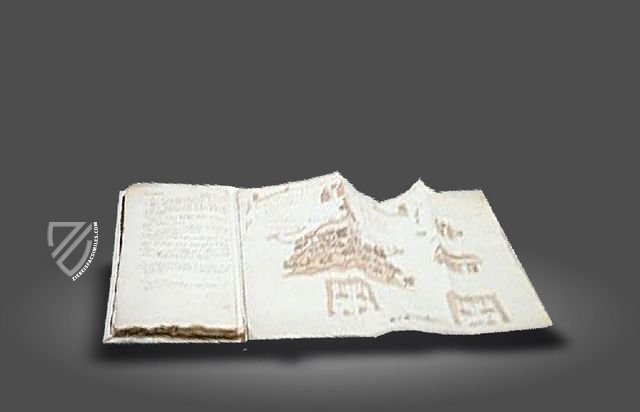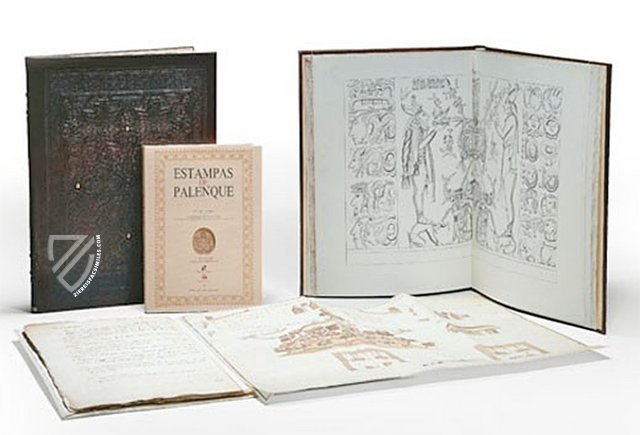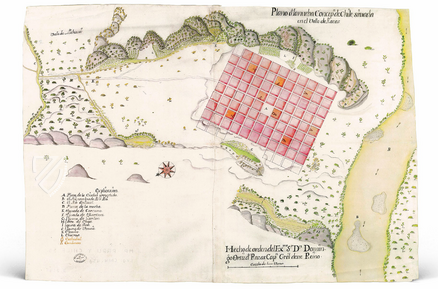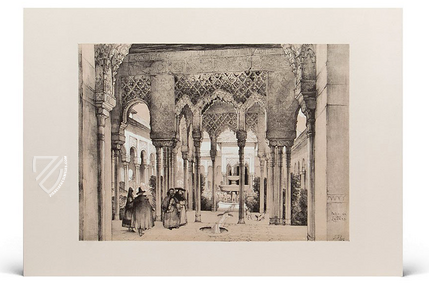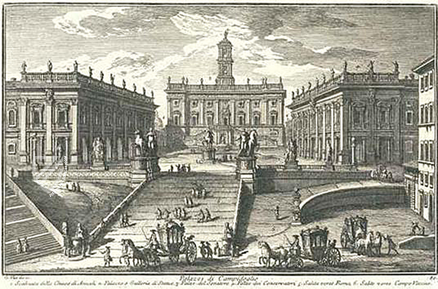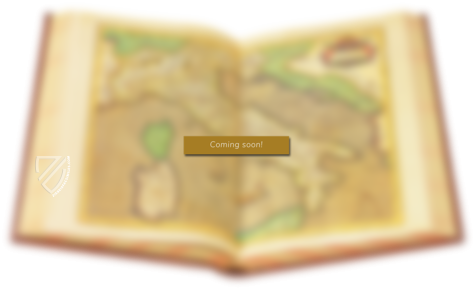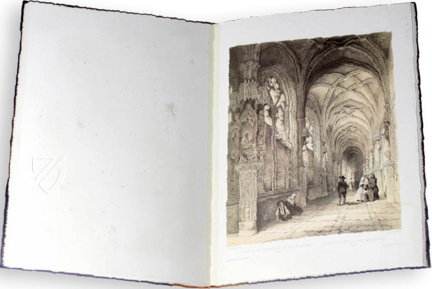Palenque Drawings
(1,000€ - 3,000€)
In the year 1786, an expeditionary group commissioned by the Spanish crown made an unbelievable discovery in the middle of the Mexican forest primeval: the famous Palenque! This city of ruins was once a center of Mayan culture. Today, the archeological site is the touristic highpoint of the country. As one of the first archeological discoveries of the Maya on the American continent, the discovery of Palenque was a sensation of the late 18th century. The expedition leader, Antonio del Río, recorded his impressions and experiences from the year 1786 in an account for the King. This was enriched with thrilling copies of the reliefs and the additional figurative ornaments of the ruins, which the draftsman Ricardo Almendariz completed as a companion of the expedition. All this offers a glimpse into the epoch’s fascinating spirit of discovery!
Palenque Drafts
In the year 1786, an expeditionary group commissioned by the Spanish crown made an unbelievable discovery in the middle of the Mexican forest primeval: the famous Palenque! This city of ruins was once a center of Mayan culture. Today, the archeological site is the touristic highpoint of the country. As one of the first archeological discoveries of the Maya on the American continent, the discovery of Palenque was a sensation of the late 18th century. The expedition leader, Antonio del Río, recorded his impressions and experiences from the year 1786 in an account for the King. This was enriched with thrilling copies of the reliefs and the additional figurative ornaments of the ruins, which the draftsman Ricardo Almendariz completed as a companion of the expedition. All this offers a glimpse into the epoch’s fascinating spirit of discovery!
Archeological Discoveries at the Behest of the Crown
Around the end of the 18th century, the inhabitants of a small village in the Mexican Chiapas Jungle made a surprising find. They discovered stone heaps that proved to be relics of an old city of ruins. This discovery roused the interest of the Spanish royal house, which quickly commissioned the exploration of the ruins – hoping for a trove of gold and other precious objects. In May of 1786, an expedition under the supervision of the engineer Antonio del Río reached Palanque. The wilderness amidst the breath-taking nature was searched through with the help of Indian workers and volunteers. The path to the ruins was cleared with axes and heavy equipment like crowbars and pickaxes. In this way, the expedition discovered an archeological sensation in the Mexican forest primeval!
Evidence of an Impressive Culture amidst Breath-Taking Nature
Palanque has been a UNESCO World Heritage Site since 1987. The archeological site in the southern Mexican highlands comprised the ruins of an old Mayan metropolis, overgrown by the jungle and hidden for the most part to this day. Palanque was a great power of the Mayan Empire from the 6th century to the mid–8th century. A settlement in the area can be substantiated from as early as the 4th century after Christ. Palenque comprises numerous splendid buildings, inter alia, a palace, a grandiose temple for the worship of deities, and ziggurats up to 20 meters tall which served as tombs for dead kings. Many of these buildings in Palanque are artfully adorned, e.g. with figurative stucco reliefs and mysterious Mayan hieroglyphics. Numerous reliefs and pictorial representations both on the walls as well as on mighty pillars in the palace. There is a depiction, inter alia, of the accession of three Mayan queens.
Copies of Mayan Art
The artworks were recorded by Ricardo Almendariz. Almendariz, an artist from Guatemala, accompanied the first expedition to Palenque under del Río as a draftsman. He made 30 drafts of the figurative bas-reliefs, which grant a glimpse in to the great art of the Mayans. Several of the reliefs from the 7th century are destroyed today, wherefore the drafts of Almendariz represent valuable documents. The drafts accompany the account of Antonio del Río, in which the discoveries and adventures of the archeological expedition were recorded. In the compendium of the account and drafts, both the admiration for the Mayans’ buildings as well as the fascination of the early archeological discoverers find unmitigated expression!
An Account for the King
These records and drafts of the first scientific expedition to the archeological site of Palanque served as proof and an informative document for the Spanish King Carlos III, the official commissioner of the expedition. “The detailed and thorough records of the expedition reached the Spanish royal court and were never made public.” The more thorough scientific examination of the city of ruins in the Mexican forest primeval first began in the second third of the 19th century. Today, Palenque is one of Mexico’s most sensational tourist attractions.
Codicology
- Alternative Titles
- Estampas de Palenque
- Type
- Manuscript on paper
- Date
- End of the 18th century
- Epochs
- Style
- Genre
- Language
- Illustrations
- 25 magnificent watercolors
- Content
- Copies of Mayan reliefs
- Artist / School
- Antonio del Río (ca. 1745 – ca. 1789) (author)
Antonio Bernasconi (1726–1805) (illuminator)
#1 Estampas de Palenque
Language: Spanish
(1,000€ - 3,000€)
- Treatises / Secular Books
- Apocalypses / Beatus
- Astronomy / Astrology
- Bestiaries
- Bibles / Gospels
- Chronicles / History / Law
- Geography / Maps
- Saints' Lives
- Islam / Oriental
- Judaism / Hebrew
- Single Leaf Collections
- Leonardo da Vinci
- Literature / Poetry
- Liturgical Manuscripts
- Medicine / Botany / Alchemy
- Music
- Mythology / Prophecies
- Psalters
- Other Religious Books
- Games / Hunting
- Private Devotion Books
- Other Genres
- Afghanistan
- Armenia
- Austria
- Belgium
- Belize
- Bosnia and Herzegovina
- China
- Colombia
- Costa Rica
- Croatia
- Cyprus
- Czech Republic
- Denmark
- Egypt
- El Salvador
- Ethiopia
- France
- Germany
- Greece
- Guatemala
- Honduras
- Hungary
- India
- Iran
- Iraq
- Israel
- Italy
- Japan
- Jordan
- Kazakhstan
- Kyrgyzstan
- Lebanon
- Liechtenstein
- Luxembourg
- Mexico
- Morocco
- Netherlands
- Palestine
- Panama
- Peru
- Poland
- Portugal
- Romania
- Russia
- Serbia
- Spain
- Sri Lanka
- Sweden
- Switzerland
- Syria
- Tajikistan
- Turkey
- Turkmenistan
- Ukraine
- United Kingdom
- United States
- Uzbekistan
- Vatican City
- A. Oosthoek, van Holkema & Warendorf
- Aboca Museum
- Ajuntament de Valencia
- Akademie Verlag
- Akademische Druck- u. Verlagsanstalt (ADEVA)
- Aldo Ausilio Editore - Bottega d’Erasmo
- Alecto Historical Editions
- Alkuin Verlag
- Almqvist & Wiksell
- Amilcare Pizzi
- Andreas & Andreas Verlagsbuchhandlung
- Archa 90
- Archiv Verlag
- Archivi Edizioni
- Arnold Verlag
- ARS
- Ars Magna
- ArtCodex
- AyN Ediciones
- Azimuth Editions
- Badenia Verlag
- Bärenreiter-Verlag
- Belser Verlag
- Belser Verlag / WK Wertkontor
- Benziger Verlag
- Bernardinum Wydawnictwo
- BiblioGemma
- Biblioteca Apostolica Vaticana (Vaticanstadt, Vaticanstadt)
- Bibliotheca Palatina Faksimile Verlag
- Bibliotheca Rara
- Boydell & Brewer
- Bramante Edizioni
- Bredius Genootschap
- Brepols Publishers
- British Library
- C. Weckesser
- Caixa Catalunya
- Canesi
- CAPSA, Ars Scriptoria
- Caratzas Brothers, Publishers
- Carus Verlag
- Casamassima Libri
- Centrum Cartographie Verlag GmbH
- Chavane Verlag
- Christian Brandstätter Verlag
- Circulo Cientifico
- Club Bibliófilo Versol
- Club du Livre
- CM Editores
- Collegium Graphicum
- Collezione Apocrifa Da Vinci
- Comissão Nacional para as Comemorações dos Descobrimentos Portugueses
- Coron Verlag
- Corvina
- CTHS
- D. S. Brewer
- Damon
- De Agostini/UTET
- De Nederlandsche Boekhandel
- De Schutter
- Deuschle & Stemmle
- Deutscher Verlag für Kunstwissenschaft
- DIAMM
- Droz
- E. Schreiber Graphische Kunstanstalten
- Ediciones Boreal
- Ediciones Grial
- Ediclube
- Edições Inapa
- Edilan
- Editalia
- Edition Deuschle
- Edition Georg Popp
- Edition Leipzig
- Edition Libri Illustri
- Editiones Reales Sitios S. L.
- Éditions de l'Oiseau Lyre
- Editions Medicina Rara
- Editorial Casariego
- Editorial Mintzoa
- Editrice Antenore
- Editrice Velar
- Edizioni Edison
- Egeria, S.L.
- Eikon Editores
- Electa
- Emery Walker Limited
- Enciclopèdia Catalana
- Eos-Verlag
- Ephesus Publishing
- Ernst Battenberg
- Eugrammia Press
- Extraordinary Editions
- Fackelverlag
- Facsimila Art & Edition
- Facsimile Editions Ltd.
- Facsimilia Art & Edition Ebert KG
- Faksimile Verlag
- Feuermann Verlag
- Folger Shakespeare Library
- Franco Cosimo Panini Editore
- Friedrich Wittig Verlag
- Fundación Hullera Vasco-Leonesa
- G. Braziller
- Gabriele Mazzotta Editore
- Gebr. Mann Verlag
- Gesellschaft für graphische Industrie
- Getty Research Institute
- Giovanni Domenico de Rossi
- Giunti Editore
- Graffiti
- Grafica European Center of Fine Arts
- Guido Pressler
- Guillermo Blazquez
- Gustav Kiepenheuer
- H. N. Abrams
- Harrassowitz
- Harvard University Press
- Helikon
- Hendrickson Publishers
- Henning Oppermann
- Herder Verlag
- Hes & De Graaf Publishers
- Hoepli
- Holbein-Verlag
- Houghton Library
- Hugo Schmidt Verlag
- Idion Verlag
- Il Bulino, edizioni d'arte
- ILte
- Imago
- Insel Verlag
- Insel-Verlag Anton Kippenberger
- Instituto de Estudios Altoaragoneses
- Instituto Nacional de Antropología e Historia
- Introligatornia Budnik Jerzy
- Istituto dell'Enciclopedia Italiana - Treccani
- Istituto Ellenico di Studi Bizantini e Postbizantini
- Istituto Geografico De Agostini
- Istituto Poligrafico e Zecca dello Stato
- Italarte Art Establishments
- Jan Thorbecke Verlag
- Johnson Reprint Corporation
- Josef Stocker
- Josef Stocker-Schmid
- Jugoslavija
- Karl W. Hiersemann
- Kasper Straube
- Kaydeda Ediciones
- Kindler Verlag / Coron Verlag
- Kodansha International Ltd.
- Konrad Kölbl Verlag
- Kurt Wolff Verlag
- La Liberia dello Stato
- La Linea Editrice
- La Meta Editore
- Lambert Schneider
- Landeskreditbank Baden-Württemberg
- Leo S. Olschki
- Les Incunables
- Liber Artis
- Library of Congress
- Libreria Musicale Italiana
- Lichtdruck
- Lito Immagine Editore
- Lumen Artis
- Lund Humphries
- M. Moleiro Editor
- Maison des Sciences de l'homme et de la société de Poitiers
- Manuscriptum
- Martinus Nijhoff
- Maruzen-Yushodo Co. Ltd.
- MASA
- Massada Publishers
- McGraw-Hill
- Metropolitan Museum of Art
- Militos
- Millennium Liber
- Müller & Schindler
- Nahar - Stavit
- Nahar and Steimatzky
- National Library of Wales
- Neri Pozza
- Nova Charta
- Oceanum Verlag
- Odeon
- Orbis Mediaevalis
- Orbis Pictus
- Österreichische Staatsdruckerei
- Oxford University Press
- Pageant Books
- Parzellers Buchverlag
- Patrimonio Ediciones
- Pattloch Verlag
- PIAF
- Pieper Verlag
- Plon-Nourrit et cie
- Poligrafiche Bolis
- Presses Universitaires de Strasbourg
- Prestel Verlag
- Princeton University Press
- Prisma Verlag
- Priuli & Verlucca, editori
- Pro Sport Verlag
- Propyläen Verlag
- Pytheas Books
- Quaternio Verlag Luzern
- Reales Sitios
- Recht-Verlag
- Reichert Verlag
- Reichsdruckerei
- Reprint Verlag
- Riehn & Reusch
- Roberto Vattori Editore
- Rosenkilde and Bagger
- Roxburghe Club
- Salerno Editrice
- Saltellus Press
- Sandoz
- Sarajevo Svjetlost
- Schöck ArtPrint Kft.
- Schulsinger Brothers
- Scolar Press
- Scrinium
- Scripta Maneant
- Scriptorium
- Shazar
- Siloé, arte y bibliofilia
- SISMEL - Edizioni del Galluzzo
- Sociedad Mexicana de Antropología
- Société des Bibliophiles & Iconophiles de Belgique
- Soncin Publishing
- Sorli Ediciones
- Stainer and Bell
- Studer
- Styria Verlag
- Sumptibus Pragopress
- Szegedi Tudomànyegyetem
- Taberna Libraria
- Tarshish Books
- Taschen
- Tempus Libri
- Testimonio Compañía Editorial
- Thames and Hudson
- The Clear Vue Publishing Partnership Limited
- The Facsimile Codex
- The Folio Society
- The Marquess of Normanby
- The Richard III and Yorkist History Trust
- Tip.Le.Co
- TouchArt
- TREC Publishing House
- TRI Publishing Co.
- Trident Editore
- Tuliba Collection
- Typis Regiae Officinae Polygraphicae
- Union Verlag Berlin
- Universidad de Granada
- University of California Press
- University of Chicago Press
- Urs Graf
- Vallecchi
- Van Wijnen
- VCH, Acta Humaniora
- VDI Verlag
- VEB Deutscher Verlag für Musik
- Verlag Anton Pustet / Andreas Verlag
- Verlag Bibliophile Drucke Josef Stocker
- Verlag der Münchner Drucke
- Verlag für Regionalgeschichte
- Verlag Styria
- Vicent Garcia Editores
- W. Turnowski Ltd.
- W. Turnowsky
- Waanders Printers
- Wiener Mechitharisten-Congregation (Wien, Österreich)
- Wissenschaftliche Buchgesellschaft
- Wissenschaftliche Verlagsgesellschaft
- Wydawnictwo Dolnoslaskie
- Xuntanza Editorial
- Zakład Narodowy
- Zollikofer AG

